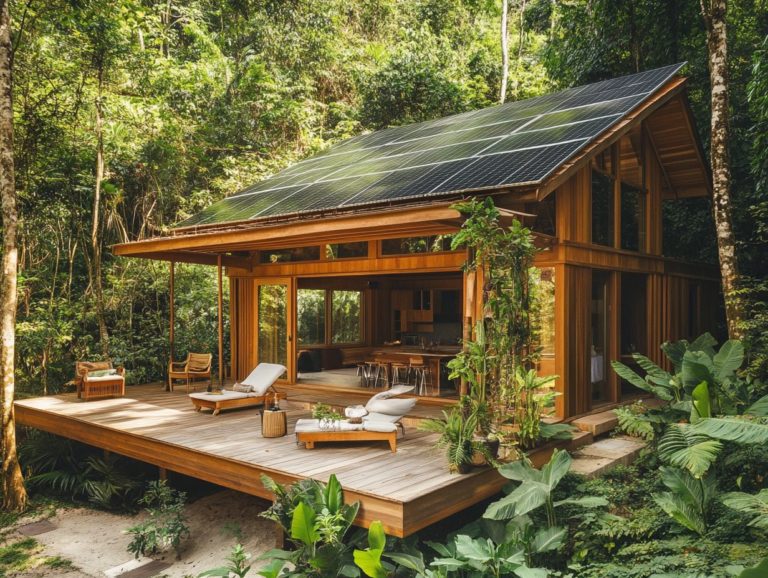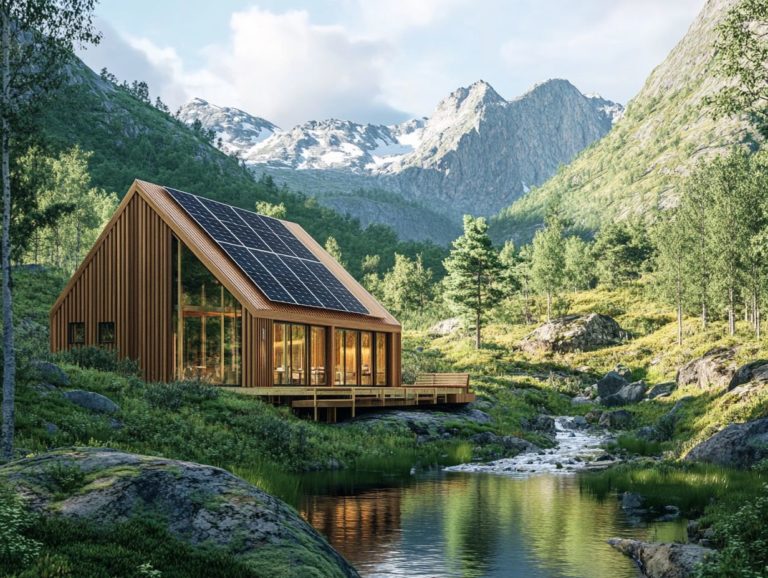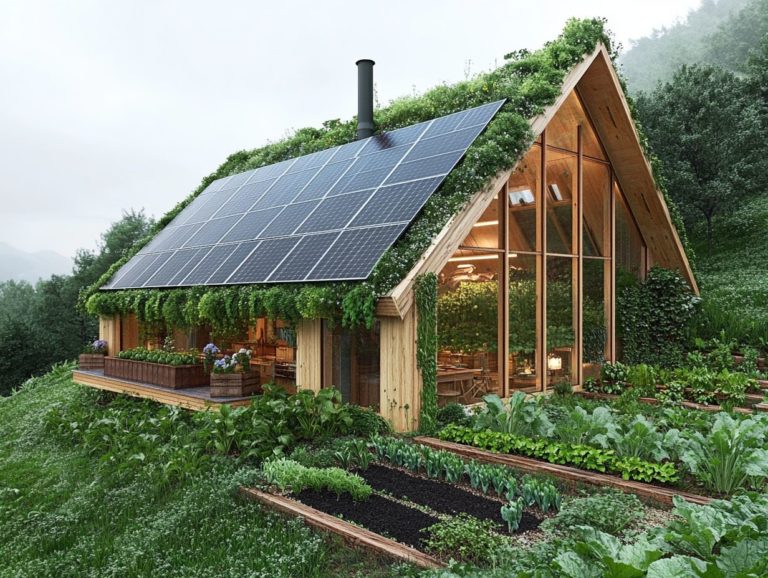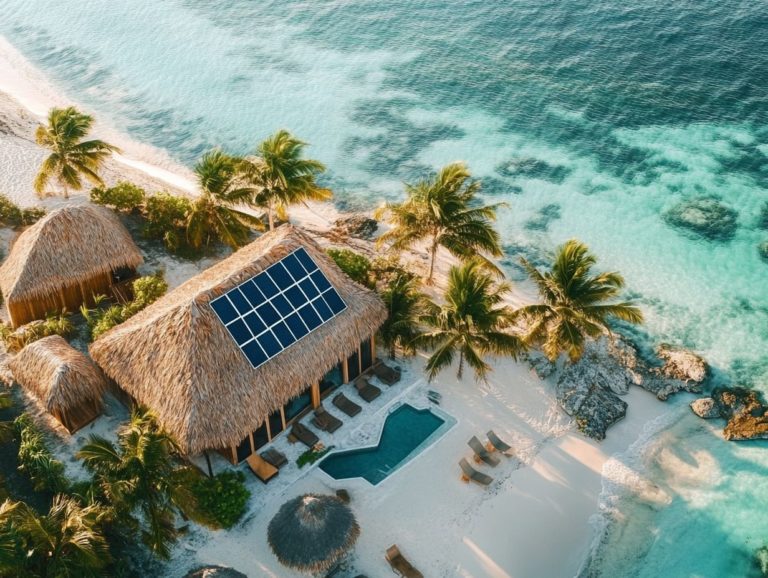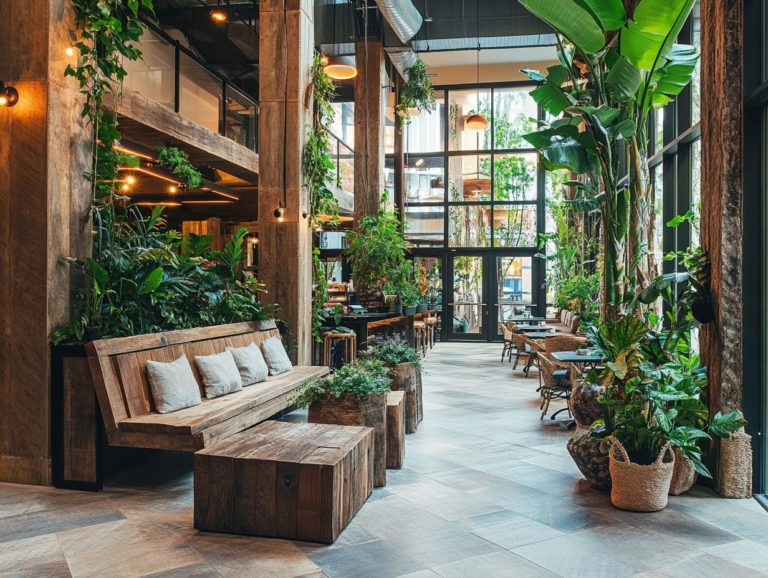Best Vegan-Friendly Hotels in the US
Are you eager to enhance your indoor space but concerned about limited natural light? Get ready to transform your space with these vibrant plants!
This article highlights the top 10 indoor plants that flourish even in artificial lighting. From the sturdy Snake Plant to the graceful Peace Lily, these green companions not only elevate your decor but also purify the air around you.
Discover the myriad benefits of incorporating indoor plants, along with essential care tips tailored for artificial light. Explore innovative ways to display them and prepare to transform your home into a vibrant oasis!
- Key Takeaways:
- 1. Snake Plant
- 2. Pothos
- 3. ZZ Plant
- 4. Peace Lily
- 5. Chinese Evergreen
- 6. Dracaena
- 7. Philodendron
- 8. Spider Plant
- 9. Dieffenbachia
- 10. English Ivy
- What Are the Benefits of Having Indoor Plants?
- What Factors Should Be Considered When Choosing Indoor Plants for Artificial Light?
- How Can One Ensure Proper Care for Indoor Plants in Artificial Light?
- Can Indoor Plants Thrive in Artificial Light Alone?
- How Can Indoor Plants Improve Indoor Air Quality?
- What Are the Best Types of Artificial Light for Indoor Plants?
- How Can One Incorporate Indoor Plants into Home Decor?
- What Are Some Creative Ways to Display Indoor Plants in Artificial Light?
- What Are Some Tips for Choosing the Right Size and Placement of Indoor Plants?
- Amazing Low-Maintenance Indoor Plants That Thrive in Artificial Light!
- Frequently Asked Questions
- What are the top 10 indoor plants that can thrive under artificial light, including durable plants for busy lifestyles?
- Can these plants survive without natural sunlight?
- How much artificial light do these plants need?
- What is the best type of artificial light for these plants?
- Can I place these plants in any room with artificial light?
- Do I need any special equipment for these plants to grow under artificial light?
- Choose low-maintenance plants for easy care in artificial light.
- Ensure proper care by selecting the right type of artificial light and incorporating plants into your home decor.
- Improve indoor air quality by choosing suitable sizes and placements for your plants and creatively displaying them.
Contents
Key Takeaways:

1. Snake Plant
The snake plant, or Sansevieria, is a top contender for your indoor gardening endeavors, especially in windowless rooms. Its extraordinary ability to thrive in low light and minimal care requirements make it a beloved choice for both beginners and seasoned green thumbs.
This resilient plant not only adjusts beautifully to varying humidity levels but also excels at purifying your air. It filters out toxins while releasing oxygen, significantly enhancing your indoor air quality.
If you re looking to welcome this green gem into your home, it prefers well-draining soil and enjoys being watered sparingly. Allow the soil to dry out between waterings.
With its striking architectural leaves that can stand tall or form a rosette, the snake plant adds a chic touch to any space. A bit of regular dusting will keep the leaves vibrant, ensuring this delightful companion remains a healthy and stylish addition to your environment.
2. Pothos
Pothos, celebrated for its trailing vines and lush green leaves, is the perfect choice for anyone seeking a low-maintenance houseplant that thrives in a variety of lighting conditions, including artificial light. This makes it an excellent fit for windowless spaces.
This resilient plant adapts effortlessly, flourishing in both bright, indirect sunlight and dimly lit areas. For the best results, water your pothos when the top inch of soil feels dry, as too much water can lead to root rot, a condition where roots begin to decay due to excess moisture.
Opting for a well-draining potting soil will help maintain healthy roots. An occasional dose of fertilizer during the growing season can promote vibrant leaf growth. With these tailored care tips, even those new to gardening can enjoy the beauty and durability of this beloved houseplant.
3. ZZ Plant
The ZZ plant, scientifically known as Zamioculcas zamiifolia, is a remarkable specimen celebrated for its resilience and ability to flourish in low light conditions. This makes it an exceptional choice for urban gardening, where sunlight can be a scarce commodity.
Its glossy, dark green leaves not only offer an appealing aesthetic but also enhance indoor air quality by filtering out common toxins. This makes the ZZ plant a splendid addition to your home or office, requiring minimal care. It thrives best with just occasional watering and a well-draining potting soil.
What truly sets the ZZ plant apart is its unique capacity to store water in its underground rhizomes. This allows it to withstand periods of neglect. Even the most forgetful plant parents can appreciate its beauty without the constant worry of daily upkeep. Its adaptability and low-maintenance nature position it as an outstanding choice for anyone looking to cultivate a serene indoor garden.
Start your indoor garden journey today and enjoy the beauty and benefits these plants bring to your home!
4. Peace Lily
The peace lily, with its exquisite white blooms and lush green leaves, elevates your indoor decor and plays a pivotal role in enhancing air quality. This plant is a top choice for indoor gardening enthusiasts, especially in low-light conditions.
To thrive, your peace lily appreciates specific humidity levels, ideally between 40% and 60%. You can achieve this by regularly misting it or using a humidity tray, which is a tray filled with water and pebbles that helps maintain moisture in the air around the plant. Aim for consistently moist soil when watering, but be careful not to overwater; checking for dryness about once a week usually does the trick.
This adaptable beauty performs beautifully under fluorescent lights or indirect sunlight, making it a perfect companion for both offices and homes. To enhance your indoor space, consider the top indoor plants for varied lighting. With the right care, you can ensure it continues to flourish, delivering both beauty and health benefits for years to come.
5. Chinese Evergreen
Chinese evergreen is a resilient houseplant that stands out with its striking variegated leaves and knack for thriving in low-light conditions. It is an ideal choice for urban gardening, especially for those seeking low-maintenance indoor plants.
This adaptable beauty comes in various types, each showcasing unique leaf patterns and colors. Caring for it is a breeze just provide occasional watering and ensure you have well-draining soil. Even the busiest individuals can enjoy its many benefits.
This plant purifies the air and filters out common toxins, contributing to a healthier living environment. By introducing it into your home or office, you can effortlessly beautify your surroundings while promoting well-being.
6. Dracaena
Dracaena stands out with its tall, striking presence and minimal care requirements. It is perfect for indoor gardeners who desire plants that thrive in low light and enhance air quality through their oxygen-producing prowess.
Among the various types, Dracaena marginata, with its edgy, spiky leaves, offers a modern flair. The Dracaena fragrans, known as the corn plant, brings a classic, lush touch to your space. Each variety has its own quirks regarding water and humidity; sturdier types prefer slightly drier soil, while others thrive with more frequent misting. For those looking to enhance their indoor environment, check out the top 5 indoor plants for humid spaces.
When integrating these beautiful plants into your indoor garden, consider their unique needs, such as placing them away from drafty windows and direct sunlight. With the right care, these resilient plants, especially the top 5 tropical plants for indoor environments, can transform into stunning focal points, enriching any indoor environment you create.
7. Philodendron
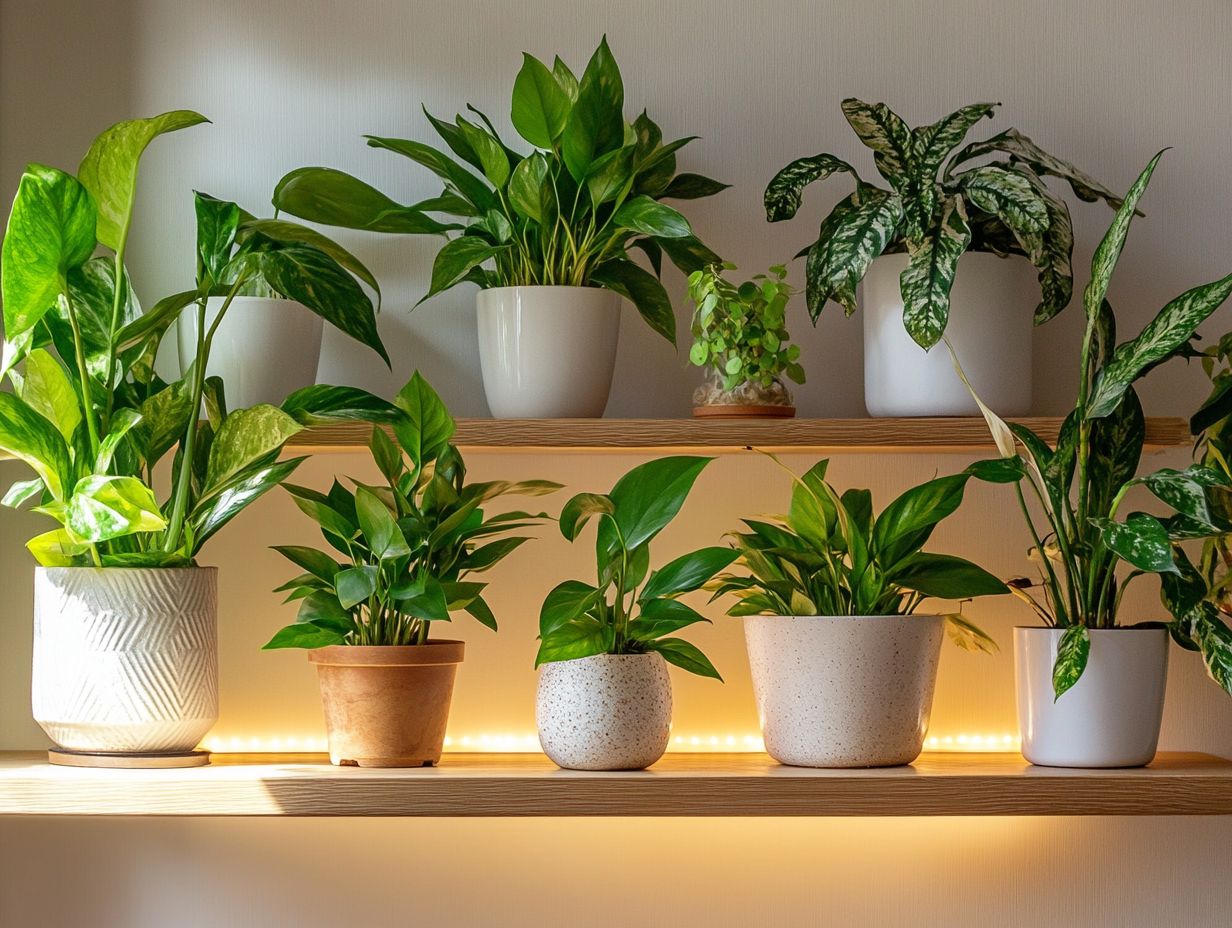
The philodendron is a cherished houseplant that exudes charm with its lush foliage and graceful trailing vines. It is an ideal choice for your indoor garden, particularly in low-light settings where minimal upkeep is desired.
This resilient gem comes in various types, each with its own unique leaf shapes and colors. From the delightful heart-shaped leaves of the Philodendron hederaceum to the impressively large, split leaves of the Philodendron bipinnatifidum, there s a style to suit every taste. Understanding their distinct growth habits is crucial; some prefer to climb or trail, while others thrive when given space to spread out.
To keep these plants thriving, focus on:
- Proper watering
- Maintaining humidity levels
- Occasional fertilization during the growing season
This attention to detail can truly transform your indoor space into a vibrant green oasis.
8. Spider Plant
The spider plant is a delightful, low-maintenance indoor companion. It thrives in various light levels and improves indoor air quality.
These resilient plants grow long, arching stems with charming little plantlets called ‘pups’. You can easily propagate them by snipping these pups and placing them in water or directly into soil.
One of the most impressive features of the spider plant is its ability to thrive in low-light conditions. With minimal care and occasional watering, this plant adds beauty to your room while contributing to a healthier indoor environment.
9. Dieffenbachia
Dieffenbachia, or dumb cane, is an elegant houseplant that thrives in low light. It is perfect for windowless rooms!
This tropical beauty boasts large, green leaves often adorned with creamy-white patterns, adding lush vibrancy to your space. To keep it thriving, place it in well-draining soil and water it thoroughly when the top inch feels dry to the touch.
Humidity is crucial for Dieffenbachia. Misting its leaves occasionally can significantly help. Regularly wiping the leaves will keep them dust-free, allowing the plant to photosynthesize effectively.
10. English Ivy
English ivy is a captivating indoor plant known for its trailing vines. It beautifies and purifies the air in your home.
This adaptable plant flourishes in various conditions. Keep the soil consistently moist avoiding waterlogging and consider misting the leaves occasionally to mimic its natural habitat.
To seamlessly integrate English ivy into your decor, hang it in stylish planters or allow it to cascade from shelves, creating a lush, green ambiance. Its climbing nature also allows for stunning displays when trained on trellises or supported by wall mounts.
What Are the Benefits of Having Indoor Plants?
Indoor plants provide numerous benefits beyond beauty. They improve air quality and boost your mental well-being.
Plants act as natural air purifiers, filtering toxins and releasing oxygen. Engaging with greenery reduces stress, creating a calming atmosphere that fills your home with tranquility.
Regularly interacting with your plant life fosters mindfulness and nurtures a sense of happiness and productivity. This is especially valuable for those navigating city living, where a little greenery can make all the difference.
What Factors Should Be Considered When Choosing Indoor Plants for Artificial Light?
You should definitely consider factors like the specific light levels available, each plant s unique growth needs, and their adaptability to indoor conditions. Consider plants such as snake plant and Chinese evergreen for their low maintenance.
Different lights include fluorescent, HID, and LED lights. LEDs are popular for their energy savings and good light for plants. For example, while succulents typically bask in bright, direct light, ferns thrive in low-light situations where harsh, direct exposure might do more harm than good. If you’re considering plants for east-facing windows, look for durable options like the Boston fern that are well-suited for those conditions.
Understanding the light spectrum, or the different colors of light that plants need, is essential. Some plants, like orchids and herbs, thrive only under specific wavelengths for optimal growth. A water meter is essential for keeping your plants healthy by gauging moisture levels.
Wondering how to keep your indoor plants thriving? Rotate your plants regularly to ensure that all sides receive adequate light, promoting even growth and preventing them from leaning awkwardly. Watch humidity and temperature levels in your environment; these factors significantly enhance overall plant health, particularly for species that thrive in tropical conditions.
How Can One Ensure Proper Care for Indoor Plants in Artificial Light?
To ensure your indoor plants thrive under artificial light, keep an eye on several factors. This includes humidity levels, watering frequency (a water meter can be your best friend here), and the specific care requirements of each plant, especially for easy care varieties like pothos and peace lily.
By regularly checking humidity with a hygrometer, you can create an optimal environment that closely mimics natural conditions. This promotes robust growth and vitality. Timing plays a crucial role; maintaining a consistent watering schedule tailored to each plant s needs will help you avoid over- or under-watering, which can lead to stress or disease.
Position your plants near humidity sources, such as pebble trays or humidifiers. This elevates the moisture in the surrounding air, which is vital for species that flourish in damp environments. Stay attuned to changes in foliage, like brown tips or drooping leaves, as these can offer important clues about their health, allowing you to make timely adjustments to your care routines.
Can Indoor Plants Thrive in Artificial Light Alone?
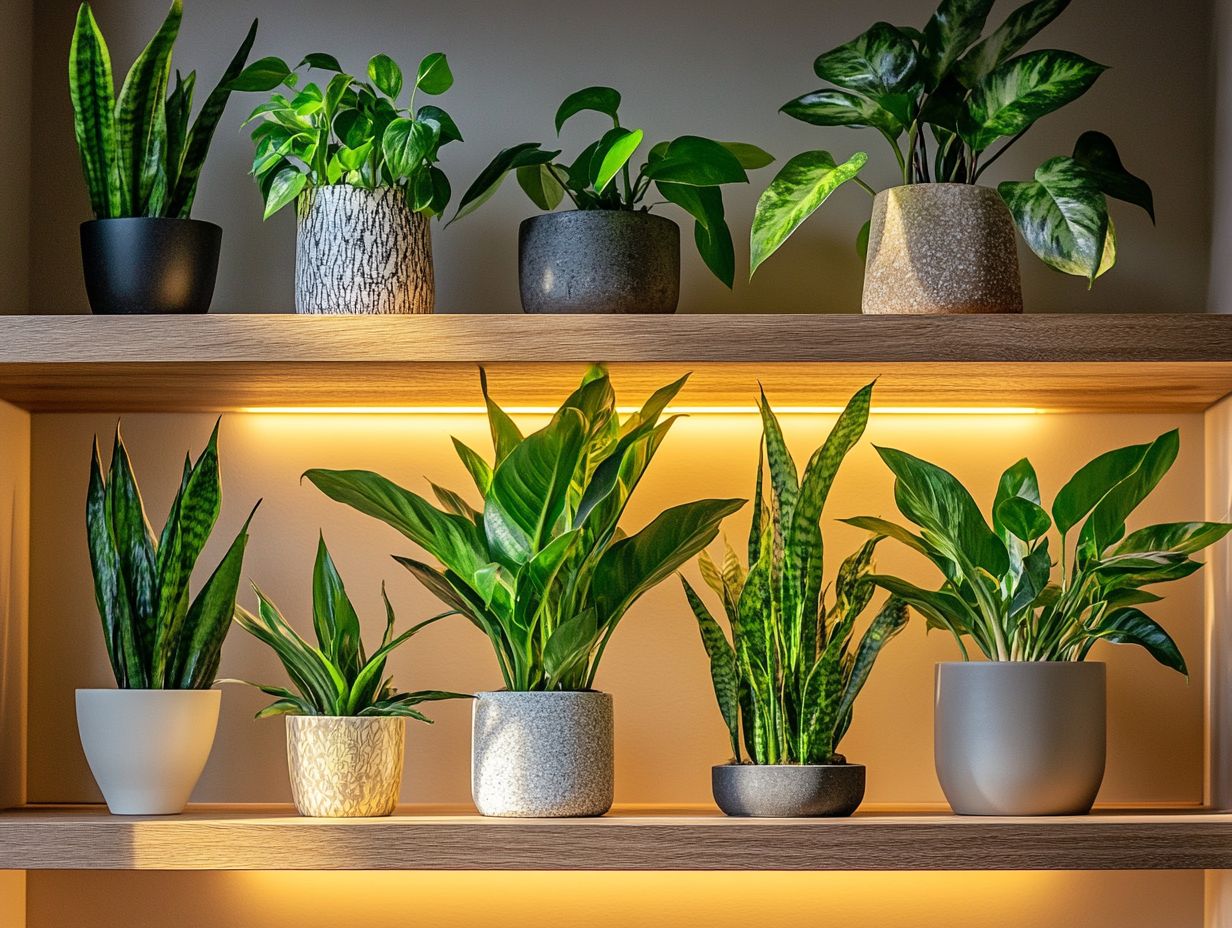
Indoor plants can indeed flourish under artificial light alone, as long as the light source provides the right intensity and spectrum to meet their growth requirements. This ensures they maintain a healthy growth rate, especially in a well-planned indoor garden.
For the best results, explore various types of artificial lighting, including fluorescent, HID, and LED options. LEDs have become especially popular due to their energy efficiency and the specific light spectrums they offer, which are tailored for photosynthesis.
In terms of light placement, position the source at the right distance from the leaves getting too close can lead to leaf burn, while being too far away might stifle growth. Adjusting the height and angle of the lights can also make a significant difference in light distribution, ensuring that each plant receives the exposure it needs for lush foliage and vibrant blooms.
How Can Indoor Plants Improve Indoor Air Quality?
Indoor plants have a remarkable ability to enhance the air quality within your home by filtering out pollutants and boosting oxygen levels. This makes them critical in urban gardening, or growing plants in cities where space is limited, where outdoor air quality can often leave much to be desired.
Plants like the snake plant and peace lily are particularly effective. Recent studies reveal that certain plant varieties excel at removing harmful chemicals like formaldehyde and benzene from the air, creating a healthier living environment for you. If you’re aiming to elevate your indoor spaces, consider the snake plant and spider plant; both are known for their adaptability and exceptional air-purifying properties. For beginners, the top indoor plants can be a great choice.
Peace lilies not only add a touch of elegance to your decor but also efficiently absorb toxins, making them a favorite among indoor gardening enthusiasts. Incorporating these plants into your home can truly transform any room into a refreshing oasis of clean air. With proper care and maintenance, they can thrive beautifully.
What Are the Best Types of Artificial Light for Indoor Plants?
The finest types of artificial light for your indoor plants are those that closely replicate natural sunlight. LED lights are particularly favored for their energy efficiency and their capacity to cater to the specific growth needs of various plant species. It s important to know how much light your plants need.
As you explore the full spectrum of lighting options, consider fluorescent and incandescent lights. Fluorescent bulbs are celebrated for their affordability and their ability to deliver a broad spectrum of light, making them suitable for a diverse array of plants, including philodendron, which thrive in such conditions. If you’re looking to enhance your space, check out the top 5 indoor plants for small apartments.
Incandescent lights provide warmth but consume more energy and generate excess heat, which can be harmful to delicate plant species. To make the most informed choice, assess the specific light requirements of your plants, along with the intended space and budget. Additionally, be aware of the top 10 pests that affect indoor plants, ensuring that your indoor garden flourishes beautifully.
How Can One Incorporate Indoor Plants into Home Decor?
Incorporating indoor plants into your home decor not only elevates the aesthetic appeal of your space but also infuses it with a refreshing touch of greenery, fostering a sense of tranquility and sparking creativity in your environment. Choose low maintenance plants for easier integration.
When considering ideal placements for your plants, take into account the light availability and the overall layout of the room. This ensures that each plant thrives while seamlessly harmonizing with your existing furnishings. For areas with less light, consider using shade-tolerant indoor plants or trailing plants for added visual interest.
Decorative pots are essential for showcasing your plants; choose styles that resonate with your decor theme whether it s minimalist, bohemian, or modern to create striking focal points. Consider pots with variegated leaves to add texture.
Arranging your plants in stylish groupings can enhance the overall design of your space. By utilizing varying heights and textures, you can create a dynamic display that breathes life into any corner of your home. Incorporate greenery that complements your existing decor.
What Are Some Creative Ways to Display Indoor Plants in Artificial Light?
Creative ways to display indoor plants can truly transform your ordinary spaces into vibrant gardens, especially when you harness artificial light to help your plants thrive while enhancing your overall decor. Using hanging plants can add depth and interest to your design.
Integrating these living elements through various display techniques not only adds a touch of nature but also elevates the aesthetic of any room. Imagine hanging plants that dangle gracefully from ceilings or shelves, allowing greenery to cascade beautifully. Wall-mounted planters serve as a stylish solution for limited floor space, turning your walls into vibrant canvases.
Don’t shy away from experimenting with unique pot arrangements on countertops or window sills; these can create delightful focal points in your space. By strategically placing artificial lighting, you can mimic natural conditions, ensuring that even your most light-sensitive plants receive the care they need to flourish. For a deeper understanding, explore indoor plant light needs.
What Are Some Tips for Choosing the Right Size and Placement of Indoor Plants?
Selecting the right size and placement of indoor plants is crucial for unlocking their full growth potential and ensuring they receive just the right amount of light. This not only enhances their health but also elevates the aesthetic appeal of your space.
When choosing plants, consider the dimensions of your room. Larger species can easily dominate smaller spaces, while tiny varieties might seem lost in expansive areas.
For optimal placement, position them where they can soak up adequate natural light, like near windows or in bright corners. Understanding the specific light requirements of each plant will guide you in finding their ideal spot; for instance, some may bask in direct sunlight, while others thrive in softer, indirect light.
Striking this balance boosts the health of your plants and creates a welcome atmosphere for anyone who steps into the room.
Amazing Low-Maintenance Indoor Plants That Thrive in Artificial Light!
Several amazing low-maintenance indoor plants can thrive even in artificial light, making them perfect for busy individuals who appreciate the benefits of greenery without the burden of extensive care commitments.
Among these, the snake plant and pothos stand out for their resilience. They require minimal watering and tolerate a range of light conditions.
The ZZ plant, with its glossy leaves, adapts well to low light and thrives on infrequent watering. However, if you’re looking to brighten up your space, consider the top 5 indoor plants for bright spaces. This is perfect for those moments when you might forget to tend to your plants.
Spider plants add a touch of elegance and are renowned for their ability to produce ‘baby’ plants that are a breeze to propagate. To keep these plants healthy, simply follow the general guideline of watering them only when the soil is dry. This way, they can flourish effortlessly in your modern indoor environment.
Frequently Asked Questions
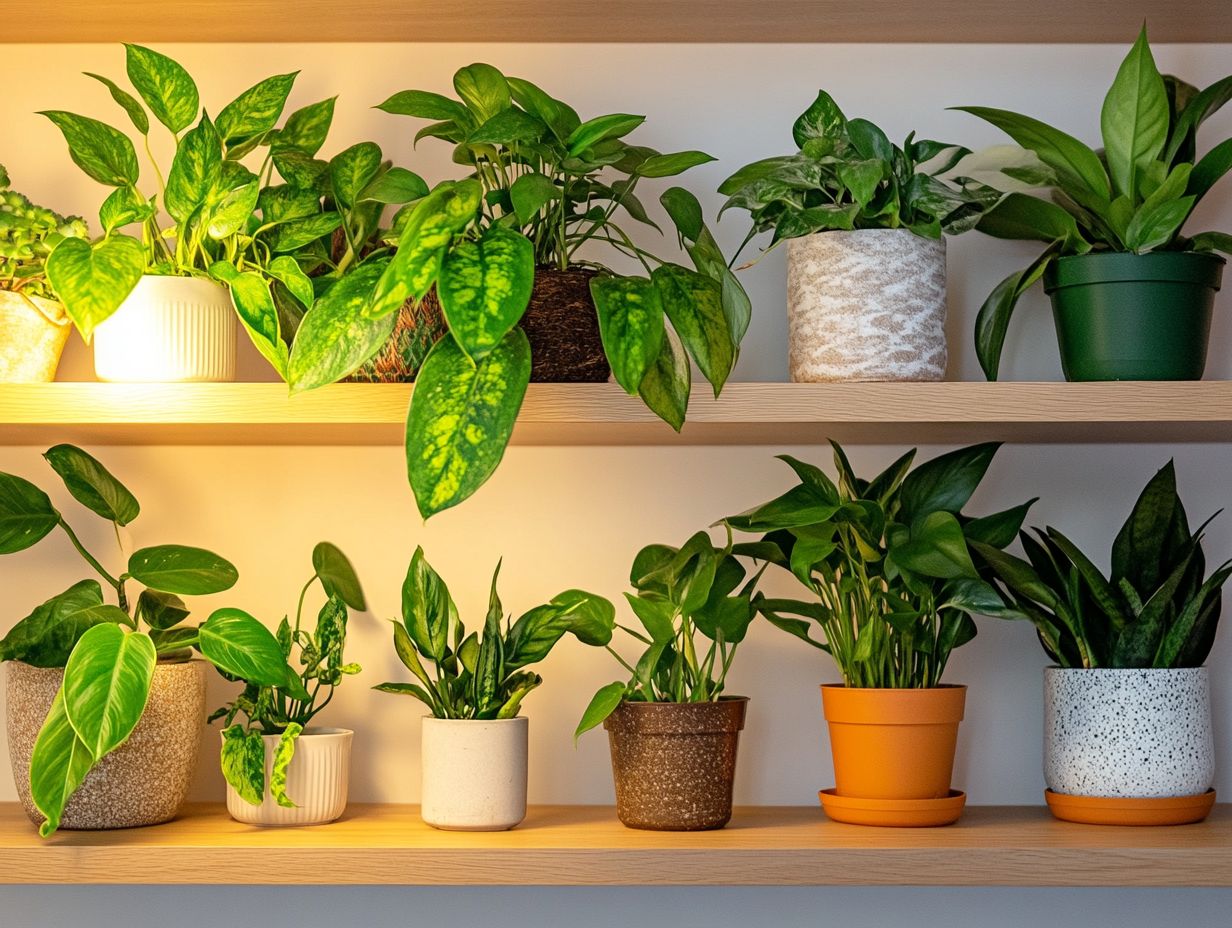
-
What are the top 10 indoor plants that can thrive under artificial light, including durable plants for busy lifestyles?
Some of the top 10 indoor plants for artificial light include pothos, snake plant, peace lily, cast iron plant, dracaena, spider plant, philodendron, ZZ plant, Chinese evergreen, and Boston fern.
-
Can these plants survive without natural sunlight?
Yes, these plants are specifically chosen for their ability to thrive under artificial light. You can also give them some natural sunlight occasionally for added benefits.
-
How much artificial light do these plants need?
The amount of artificial light needed varies for each plant. In general, they should receive around 12-16 hours of artificial light per day. Make sure to read the specific care instructions for each plant to determine its light requirements.
-
What is the best type of artificial light for these plants?
The best type of artificial light for indoor plants is full-spectrum LED lights. These lights provide a balanced spectrum that mimics natural sunlight, making them ideal for plant growth.
-
Can I place these plants in any room with artificial light?
Yes, you can place these plants in any room with artificial light, as long as they receive the recommended amount. However, avoid placing them near air vents or drafty areas, as this can negatively affect their growth.
-
Do I need any special equipment for these plants to grow under artificial light?
No, you do not need any special equipment for these plants to grow under artificial light. However, using a timer for your lights can help ensure that the plants receive consistent and adequate light.

